 Κιβωτόσχημος τάφος Α.Κρατήρας.
Κιβωτόσχημος τάφος Α.Κρατήρας.
 Κιβωτιόσχημος τάφος Α. Πάπυρος με ορφικό κείμενο.
Κιβωτιόσχημος τάφος Α. Πάπυρος με ορφικό κείμενο.
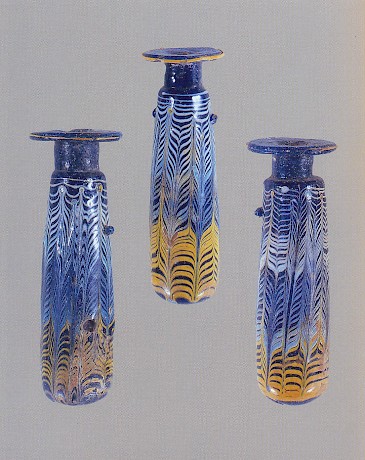 Κιβωτιόσχημος τάφος Α. Αλάβαστρα.
Κιβωτιόσχημος τάφος Α. Αλάβαστρα.
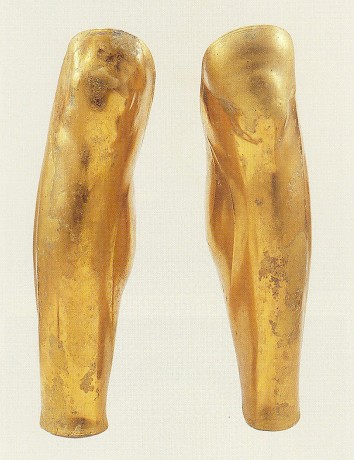 Κιβωτιόσχημος τάφος Α. Περικνημίδες.
Κιβωτιόσχημος τάφος Α. Περικνημίδες.
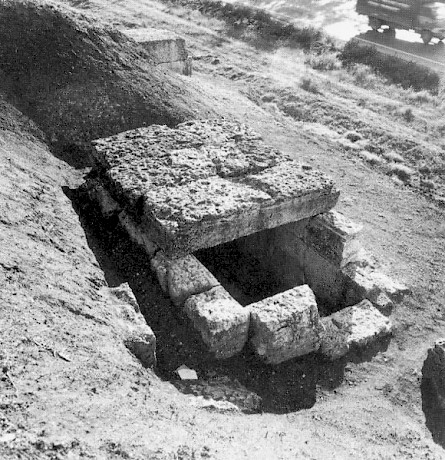 Ο κιβωτιόσχημος τάφος Β.
Ο κιβωτιόσχημος τάφος Β.
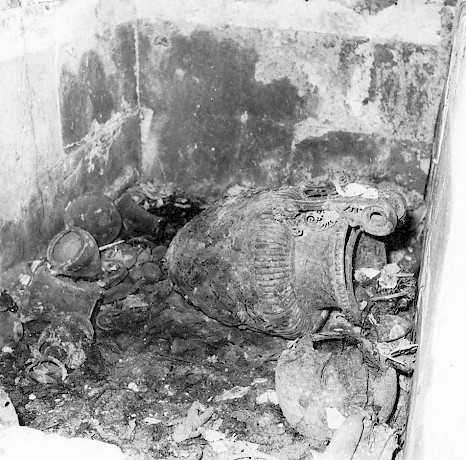 Το εσωτερικό του κιβωτιόσχημου τάφου Β.
Το εσωτερικό του κιβωτιόσχημου τάφου Β.
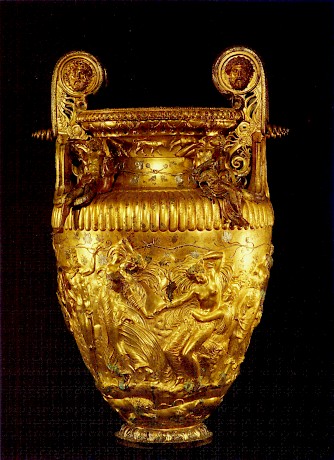 Κιβωτιόσχημος τάφος Β. Χάλκινος κρατήρας με θέματα εμπνευσμένα από τον κύκλο του Διονύσου.
Κιβωτιόσχημος τάφος Β. Χάλκινος κρατήρας με θέματα εμπνευσμένα από τον κύκλο του Διονύσου.
 Κιβωτιόσχημος τάφος Β. Χρυσός στέφανος μυρσίνης.
Κιβωτιόσχημος τάφος Β. Χρυσός στέφανος μυρσίνης.
 Κιβωτιόσχημος τάφος Δ. Χρυσός στέφανος ανθισμένης μυρσίνης.
Κιβωτιόσχημος τάφος Δ. Χρυσός στέφανος ανθισμένης μυρσίνης.
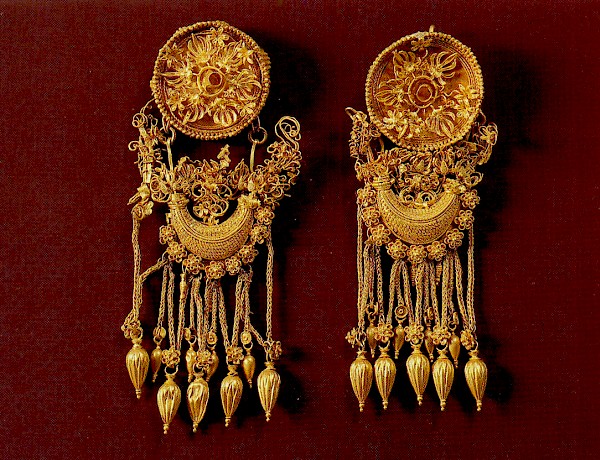 Κιβωτιόσχημος τάφος Ζ. Ζευγάρι χρυσών ενωτίων.
Κιβωτιόσχημος τάφος Ζ. Ζευγάρι χρυσών ενωτίων.
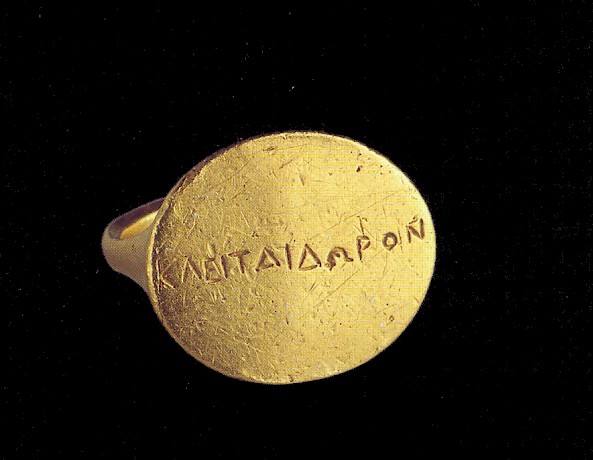 Κιβωτιόσχημος τάφος Ζ. Δαχτυλίδι με επιγραφή.
Κιβωτιόσχημος τάφος Ζ. Δαχτυλίδι με επιγραφή.
The cist graves
Tomb A
It is a cist grave made of blocks of poros laid in two courses of isodomic masonry and covered by similar blocks. The interior is coated with white plaster decorated with a zone of a guilloche of blue leaves and berries on a red ground bordered by a yellow and a blue band.
The remains of the cremation were gathered in a large bronze volute krater withremains of cloth stuck to its rim and shoulders. It also contained the remains of a gold wreath of oak leaves and fragments of a second wreath with gilded decorative parts. There was a large set of copper and clay pots accompanying the dead. Among them stand out abronze krater and a lebes, jugs, situlae, a patera, the cast handle of which has got a ram’s head finial, a "Cypriote" amphora, black-glazed pottery, alabastra and glass vessels. Unique miniature works of art are theivory fragments of female figures from wooden kits, as well as the gilded pieces of bronze sheet in the shape of shields depicting Thetis with Achilles’ weapons and the gilded buttons with the head of Athena Parthenos.
In the remains of the funeral pyre on top of the covering slabs, there were spearheads and spearbutts, a pair of bronze greaves, pieces from a cuirass and a carbonized papyrus scroll with an orphic text.
Above the grave,six clay doric column capitals were placed on a wooden structure in the form ofaDoric temple. The ivory eyes found in the pyre indicate the presence here of clay masks –images of chthonic deities or of the deceased, a ritual known both from written sources and other burials of the Mediterranean region.
Tomb B
It is a cist grave constructed of poros blocks in three courses of isodomic masonry and roofed with similar block stones. The walls of the chamber were coated and decorated with two plaster zones. The lower is red and the upper is white with a guilloche of olive(?) branches with blue-red leaves and black berries. There were iron nails for hanging offerings at regular intervals along the sides of the tomb.
The remains of the cremation were collected in a bronze volute krater decorated with Dionysiac scenes on the hammered body. It was probably placed on a rectangular poros block with a circular cutting in the middle, in which the vessel’s base fitted. On the concave perforated lid of the krater a wreath with gilded parts was placed. A woman was also buried with the deceased, perhaps his companion, whose bones were wrapped in a purple cloth. The inscription inlaid with silver lettering on the rim reveals the name of the deceased.He is Astiouneios from Larissa in Thessaly, of the family of Alevades. Inside the krater, some of the jewels of the deceased, i.e. two gold double pins, a gold finger-ring etc, wasfound.
A large set of symposium vessels accompanied the deceased, bronze arytainae, a lagynos, a strainer funnel, kylikes, and silverware, such asa kantharos, plates etc. There were also black-glazed vessels and alabastra. In the northwest corner,his armor (spears and swords) was deposited.
Tomb C
It is a single-chamber Macedonian tomb with a pedimental façade made of poros blocks. The door opening was sealed with large blocks of sandstone. The door leafs were found broken and piled up on the floor of the chamber. Along the north side of the chamber, a ledge built of red-plastered stones supported a red-figure pelike, which probably contained the remains of the cremation. The tomb was looted at least four times. Remains of a dead man were found in the deposits above the top of the tumulus. Inside the chamber two disturbed skeletons were found. Fragments of an oinochoe, a handless skyphos, a fish-plate etc were the offerings to the deceased.
Tomb D
It is a cist grave made of poros blocks in three courses of isodomic masonry. It had no covering slabs but only a wooden roof of planks supported on beams. The interior was coated with white plaster and decorated with a blue band. The dead man was buried accompanied with his armor, metal vessels of a symposium (a bronze phiale, situlae, one with a spout in the shape of a bull’s head and with the head of a woman attached to the opposite side, a strainer, an oenochoe), clay vessels, alabastra, wreaths with bone-stem and gilded or gold leaves, an eighth-stater of Philip II etc. The tomb contained also a second female burial.
Tomb E
It is an almost square cist grave made of poros blocks placed in two courses and covered with similar slabs. The floor is also paved with slabs. There was a ledge along the east side supporting a wooden chest that contained the cremated bones. The interior surfaces of the walls and the covering slabs were coated with red plaster. Bone plaques incised with scenes of Aphrodite and Eros and a pair of griffins tearing apart a deer, were attached to the wooden chest.
The grave offerings consistedoffragmentary alabastra, gold beads,femaleterracotta protomes, two coins of Phillip II and Alexander III, and gilded clay roundels with a repoussé head of Athena Parthenos.
Tomb Z
It is a pit grave covered only by wooden beams and planks and plastered on the inside. The grave offerings comprised mainly of bronze vessels and gold jewellery, for example a bronze krater and a situla, a silver kantharos with a Silenos mask on the bottom, gold fibulae, a necklace, a gold embossed amulet in the shape of a head of Herakles, two gold finger-rings with a sard in the bezel etc. The gold finger-ring with the inscription Κλείταιδώρον on the bezel probably reveals the name of the dead woman.
Tomb H
It is a small cist grave made of four poros blocks and covered by a similar block. It was coated with plaster inside. It had been looted and its contents had been scattered around. The offerings consisted of a calyx krater with a gilded relief ivy branch, a “Cypriote” amphora, fragments of a terracotta doll (plangona), a gold earring and fragments of bronze vessels. An attic red-figure pelike with a scene of Aphrodite and Eros contained probably the remains of the cremation.
Anna Panti,archaeologist